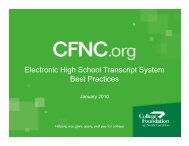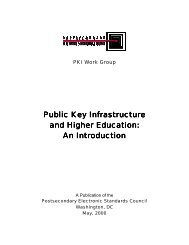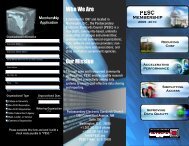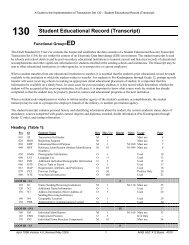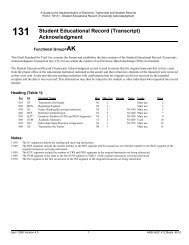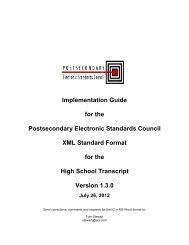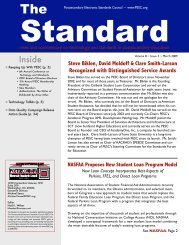February 2013 - PESC
February 2013 - PESC
February 2013 - PESC
You also want an ePaper? Increase the reach of your titles
YUMPU automatically turns print PDFs into web optimized ePapers that Google loves.
2012 Survey of Chief Information Officers<br />
11<br />
Core Administrative Applications Are<br />
institutions had their administrative systems tightly<br />
integrated. Of those surveyed, 75% responded that their<br />
solutions where tightly integrated, compared with 23%<br />
responding that their systems were loosely integrated<br />
and 2% responding with no integration.<br />
From the survey result, one can overwhelmingly conclude<br />
that higher-education institutions prefer tightly integrated,<br />
vendor-supplied systems for their business needs.<br />
Grants Management<br />
2010 2011 2012<br />
Best-of-breed 7.9% 10.5% 7.5%<br />
Home-grown 7.4% 5.9% 5.5%<br />
Outsourced 0.5% 0.7% 1.5%<br />
Open-source 0.5% 0.0% 0.0%<br />
Vendor-supplied 80.2% 80.4% 85.6%<br />
Percentage of Modules Supplied by Vendors<br />
72.3%<br />
In-house or outsourced<br />
Some institutions choose to outsource business<br />
processes. The results of the LBCIO survey show that<br />
when it comes to administrative systems, very few<br />
institutions outsource their administrative applications.<br />
Fewer than 2% of those who responded to the survey<br />
indicated that they outsource core administrative<br />
systems. Only 2% outsource financial systems, 3.5%<br />
outsource advancement systems, and 4% outsource<br />
human resource systems.<br />
We continue to see more institutions moving certain<br />
applications to the cloud. E-mail and learningmanagement<br />
systems seem to be the most popular. Will<br />
the future of administrative systems take these core<br />
business systems to the cloud as well? From our survey<br />
responses over the past three years, it appears that this<br />
movement of administrative applications to the cloud is<br />
slower than the hype about such movement. In 2012,<br />
only 6% indicated that they have either placed or are<br />
working on placing financial applications in the cloud.<br />
One trend that we may begin to see more is that of<br />
shared services and partnerships when it comes to<br />
administrative systems. As institutions continue to seek<br />
to lower their costs, more institutions find themselves<br />
needing to consider shared services or collaboration.<br />
This year’s survey indicated that 72% were looking at<br />
shared services and collaboration models as a way to<br />
save money.<br />
Advancement<br />
Payroll<br />
Human Resources<br />
Financial Aid<br />
Student Registration, Grading, Transcripting<br />
Financials (GL, AP, AR...)<br />
91.3%<br />
87.1% 6.1%<br />
89.1%<br />
92.8%<br />
90.6%<br />
94.6%<br />
Upgrade Planning<br />
Administrative systems take a considerable amount<br />
of money, time, and effort to implement and maintain.<br />
No university can really exist without them. Once these<br />
systems are in place, most institutions do not want to<br />
go through the process of changing them again for a<br />
considerable amount of time. So, what are institutions<br />
planning for replacements or major upgrades to their<br />
administrative systems?<br />
Most institutions are currently implementing new<br />
systems, upgrading current systems, or planning<br />
replacements or major upgrades to their financial,<br />
student system, human resources, or advancement<br />
systems within the next six years.<br />
Over the past 30 years of using IT to support the<br />
management of higher-education institutions, we<br />
have found that in any given year, about 10% to 15%



